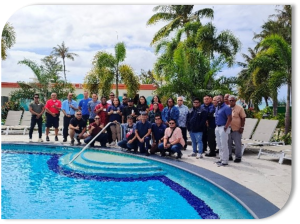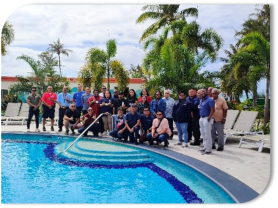From Risk to Regulation: CNMI’s Code for Safer Swimming and Stronger Public Health
- By: Chloe Lake
- Date
With support from the National Environmental Health Association, the Council for the Model Aquatic Health Code, and the Public Health Infrastructure Grant (PHIG), the Commonwealth of the Northern Mariana Islands (CNMI) is standardizing water safety with its first-ever Aquatic Health Code.
In the Commonwealth of the Northern Mariana Islands (CNMI), pools, spas, and other aquatic facilities like waterslides and interactive water features are a mainstay of both everyday recreation and tourism. But without a formal aquatic health code or inspection program in place, CNMI lacked the infrastructure necessary to regulate water safety, prevent recreational waterborne illnesses, and respond effectively to concerns from locals and tourists alike. The absence of regulatory standards left pool operators and facilities without standardized guidance, limiting public trust in the safety of these facilities. Additionally, CNMI was not prepared to respond effectively to emergencies or contamination events. In light of these challenges, Commonwealth Healthcare Corporation’s Environmental Health Disease Prevention Program (CHCC-EHDP) requested technical assistance through the Public Health Infrastructure Grant (PHIG), seeking expert support to design an aquatic health regulatory framework tailored to the islands’ unique public health and tourism landscape.
Using National Expertise to Build Local Capacity
The National Environmental Health Association (NEHA) partnered with the Council for the Model Aquatic Health Code (CMAHC) to support CHCC-EHDP. This collaboration kicked off with an in-person workshop in Saipan on February 25 and 26, 2025. The workshop brought together 32 representatives from public and private sectors, including environmental and public health, emergency services, hospitality, consumer advocacy groups, and more. Together, the group set out to adapt the CDC’s Model Aquatic Health Code (MAHC) to the needs and context of CNMI, worked together to identify key challenges, and developed practical strategies related to implementation, education, and enforcement of the new regulatory framework.
The hotel industry and local pool operators were key partners, bringing operational expertise and facility-level perspectives to shape the code’s relevance and feasibility. Representatives from emergency services, public works, water quality, and construction were also in attendance to better define their role in creating safer water in aquatic facilities. Participants welcomed the opportunity to collaborate on an essential public safety project.
“This partnership helped us turn a long-standing goal into a reality. We’re proud of what we’ve built, and we know it’s going to protect our community.”
– Workshop Participant
From Planning to Practice: Rolling Out CNMI’s First Aquatic Health Code
Over the course of 10 months, NEHA will work closely with CHCC-EHDP to develop and roll out CNMI’s first aquatic health code – one that reflects the CDC’s evidence-based Model Aquatic Health Code while adapting it to the islands’ unique needs. Environmental health staff, public works officials, and pool operators will receive hands-on training to support the consistent application and enforcement of the new code. A second in-person training event was held in June 2025.
Safer Swimming: How the Aquatic Health Code Impacts Community Health
As a result of NEHA’s technical assistance, CNMI is building a standardized, enforceable framework that will make pools and other aquatic facilities safer for everyone. The new code and inspection framework will help staff conduct more effective educational outreach, respond to concerns, and ensure that robust health and safety protections are integrated into daily aquatic facility operations.
“Before this process, we didn’t have the tools to ensure every pool in CNMI met even basic health standards. Now, we not only have the tools — we have the training, the code, and the community buy-in to make real change.”
– Public health official
Community members and visitors will enjoy safer public pools and other aquatic facilities, supported by more consistent water quality monitoring and a reduced risk of recreational waterborne illnesses. These protections will serve as a vital safeguard for families, children, and tourists who rely on clean, safe, and well-maintained recreational spaces. This structured approach will not only raise public health standards in CNMI, it will foster greater accountability, consistency, and public confidence in aquatic environments throughout the territory.
This work is supported by funds made available from the Centers for Disease Control and Prevention (CDC) of the U.S. Department of Health and Human Services (HHS), National Center for STLT Public Health Infrastructure and Workforce, through OE22-2203: Strengthening U.S. Public Health Infrastructure, Workforce, and Data Systems grant. The contents are those of the author(s) and do not necessarily represent the official views of, nor an endorsement, by CDC/HHS, or the U.S. Government.



 Subscribe To Our Communications
Subscribe To Our Communications